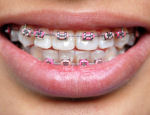
Dental Braces Care
Food particles are very easily trapped between dental braces and the teeth surface, providing a suitable environment for the formation and growth of dental plaque. The bacteria of the dental plaque feed on sugars and produce acids. The acids damage the tooth enamel causing tooth decay, and irritate the gums causing gum disease and receding gums. Bad breath is another problem caused by the accumulation of dental plaque on teeth and gums.
Wearing dental braces can have a negative effect on your dental health, if you neglect your daily oral hygiene routine. Actually you must follow it much more carefully than you did before wearing dental braces.
How To Take Care Of Dental Braces
- Ask your orthodontist to give you instructions on how to better clean the teeth surfaces around the dental braces.
- Brush your teeth thoroughly three times a day with fluoride toothpaste. Pay special attention to the areas between your brackets and your gums. Brush after every meal to make sure that you clean food debris trapped in or around braces.
- Use a soft orthodontic toothbrush. Some brands offer toothbrushes for orthodontic use especially designed for dental braces care. Orthodontic toothbrushes usually have longer bristles on the edges and shorter ones in the middle, to help cleaning between dental braces and teeth.
- You can also use an electric toothbrush with soft bristled head for dental braces cleaning. If it has adjustable speed, use a moderate setting so as not to break or loosen orthodontic appliances.
- An interdental brush can be used to fit between the wire and the tooth to remove hard-to-reach plaque and food debris.
- Floss at least once a day. You may think that it is not possible to floss while you wear dental braces, but you can. Special flossing products, floss threaders and floss, can help in passing dental floss under archwires to facilitate flossing of the teeth between the wires and the gumline. Ask your orthodontist to demonstrate the proper flossing technique, after your braces are first put on.
- Oral irrigators can be used in addition to regular brushing and flossing. These instruments shoot small streams of water onto the teeth at high pressure removing food debris and plaque from between teeth and dental braces.
- A mouthwash containing fluoride can be used complementally to help strengthen teeth enamel and prevent tooth decay during orthodontic treatment.
- Dental Visits - Regular visits to your dentist are important to monitor the health of the teeth and gums during orthodontic treatment. Visit your dentist at least twice a year for a checkup and cleaning.
If you do not take proper care of dental braces during orthodontic treatment, the risk of tooth decay and periodontal disease is significantly increased.
Foods to Avoid While Wearing Braces
There are some foods and drinks that should be avoided while you're wearing dental braces or a retainer, because they could either increase the risk of cavities, or might damage the brackets or wires. These include:
- chewing gum and other sticky, chewy foods, such as caramels because they get stuck in the in the wires and brackets and may damage them. Sticky foods also make proper dental braces cleaning much more difficult.
- sugary foods, sweets and soft drinks that increase the risk of tooth decay
- large quantities of fruit juice that could cause enamel erosion
- hard foods such as carrots or nuts, because they can bend the wires, loosen the bands, or break the brackets. Fruits and raw vegetables should be cut up into smaller pieces and chewed on the back teeth.
Playing Sports While Wearing Dental Braces
Orthodontists advise all patients with dental braces to wear a mouthguard while riding a bike, skating, or playing any contact sports. Getting a hit in the mouth without a mouthguard when having dental braces can cause much larger damage to the soft tissues of the mouth (gums, lips, cheek) than normal, due to their contact with the edges of brackets, wires etc.
![]() The cost of orthodontic treatment can be significant and many patients may not afford it if they are not covered by their dental insurance.
Learn how to choose a dental insurance plan that will provide the best dental treatment to you and your family.
The cost of orthodontic treatment can be significant and many patients may not afford it if they are not covered by their dental insurance.
Learn how to choose a dental insurance plan that will provide the best dental treatment to you and your family.

